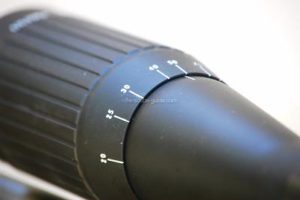

Reticles that are not securely mounted and allowed to move even a few thousandths of an inch, will always have changing amounts of parallax. If the reticle is not precisely placed the correct distance from the objective, the distance of no parallax will be exaggerated. In lower-quality scopes, there are other sources of parallax. In most rifle scopes this one point of zero parallax is usually placed at a suitable mid-range point in the scopes’ focal range. It is also important to know that in every scope, there is some one shooting distance at which there is no parallax. It is important to know that in every scope, there is some parallax. An exit pupil small enough to do this would be impractical. There is no parallax, at any distance, as long as the eye is lined up exactly with the optical axis of the scope. The distance the eye can move from the optical axis of the scope, is determined by exit pupil size. Since the reticle is in a fixed position within the scope housing, the image is not always formed in the same plane as the reticle and, hence parallax.Ģ. Closer targets are formed farther away from the objective and farther targets are formed closer to the objective. The actual position at which the image is formed is dependent on the distance the target is from the objective. The distance of the target to the objective–The objective lens forms a primary image of the subject being viewed and subsequent components invert the image, and there is no parallax. TWO FACTORS WHICH CAUSE AND DETERMINE THE AMOUNT OF PARALLAX IN A RIFLESCOPE:ġ. Scopes of lower magnification are not usually supplied with parallax adjustment either, because at lower powers the amount of parallax is so small as to have no importance for practical, fast target acquisition. Tactical style scopes are not usually supplied with parallax adjustment because the exact range of the target can never be anticipated. This adjustment of the objective part of the optical system would ensure that the target can be brought in the exact focal plane of the reticle at any distance. High magnification scopes, or scopes for long-range shooting, where even slight sighting errors would be serious, should be equipped with a parallax adjustment. If the primary image is formed on the same focal plane as the reticle, or if the eye is positioned in the optical axis of the scope, then there is no parallax, regardless of the position of the primary image.

If the eye is moved from the optical axis of the scope, this also creates parallax. In a telescopic sight, parallax occurs when the “primary image” of the object is formed either in front of, or behind the reticle. Parallax can be defined appropriately to rifle scopes as the apparent movement of objects within the field of view in relation to the reticle. There seems to be a great amount of misunderstanding and confusion concerning this subject. Whenever rifle scopes are discussed, a topic that frequently arises is parallax.

Rifle Scope Parallax Focus from our good friends at US Optics


 0 kommentar(er)
0 kommentar(er)
